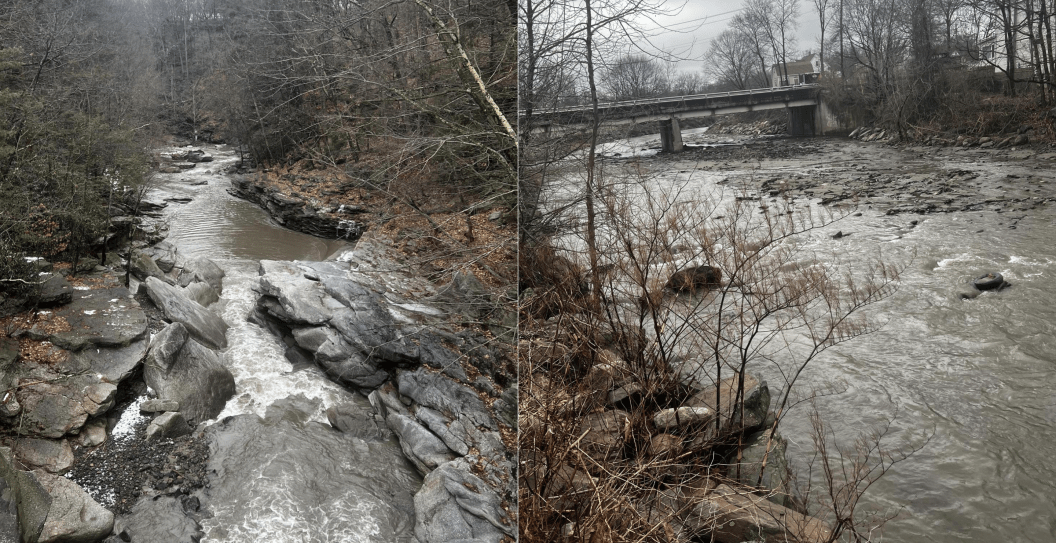Last week when Bill Keating, 28, set out from his home in Dunmore, Pennsylvania to fish Roaring Brook in Lackawanna County, he thought he'd have a shot at catching a few wild brown trout or even a nice native brookie. Keating's been fishing the area, just outside of Scranton, for 10 years; his father fished there when he was a kid, and his grandfather, too. And he's not alone: Roaring Brook is designated as a "High-Quality Coldwater Fishery," a "Migratory Fishery," and a "Class A Wild Trout Waters" by the state of Pennsylvania.
Keating expected to hike along the forested and rocky small river he's come to love. He was shocked by what he found: a chocolate-colored river choked by sediment, some in banks "two-plus feet high."
"It was like a tornado went through," he tells Wide Open Spaces. "I've never seen anything like it." Keating says sediment also washed through Nay Aug Gorge and Nay Aug Falls, which are on the National Register of Geologic Landmarks.
County commissioner Bill Gauhan confirmed what Keating saw: Massive amounts of sediment had flowed downstream from the Number 7 Reservoir in Dunmore, where the 152-year-old dam is currently undergoing a $17 million rehabilitation project as required by the PA Department of Environmental Protection.
Roaring Brook was dammed in the late 1800s to create the Number 7 as a drinking water source. Upstream of the reservoir is coal country, where in the 19th and 20th centuries, Lackawanna County was among the largest producers in the U.S., shipping out upwards of 40,000 tons a day. But time has taken its toll: Since the dam, significant sediment banks have built up in the reservoir "20 feet deep at points," Keating observed.
Pennsylvania American Water, the company that owns the dam and is responsible for the rehabilitation project, told local news that lowering water levels in the reservoir resulted in the reservoir's sediment flowing downstream. They also said they had all the necessary work permits and that they are continuing to operate within permitting commissions.
Keating alleges that contractors had zero mitigation in place for the sediment, which is now flowing into the Lackawanna River. To that end, Lackawanna County commissioners have asked for a criminal investigation to be conducted.
"The goal is that this is investigated to see what rules were and were not followed, and who is responsible for this, and to hold them accountable, because this is outrageous," county commissioner Gauhan told Fox 56 local news. "The other concern I have is that it's about 400 yards away from the landfill, and I think DEP should go in and make sure they test that sediment."
Regardless of the findings, the event itself may be catastrophic for the ecosystem. In the immediate aftermath of sediment release, an influx of sediment in the river is likely to deplete dissolved oxygen levels, causing sub-lethal health effects or even mass mortality events for fish and other animals. Longer-term consequences include a loss of diverse habitat for fish.
"The excessive sedimentation is expected to suffocate spawning gravels, leading to the loss of critical spawning habitat and potentially harming developing eggs and larval fish," says Russell Marlow, a wild trout biologist and senior project manager at California Trout, a fish and water conservation nonprofit. "Next up the food chain, the sediment will bury essential juvenile rearing and foraging habitats and then it will also fill larger pool habitats where adult fish typically reside. The natural transportation of excessive sediment downstream may take considerable time."
The DEP has taken three samples from Roaring Brook, one downstream from a silt screen/boom near the dam project and the other two from stockpiled dredged material originally deposited behind the dam. The samples will be analyzed for compounds including solids, dissolved metals, and PFAS, so-called toxic "forever chemicals."
Wide Open Spaces editors will update this story as more information becomes available.
READ MORE: Train Derailment Threatens California's Famed Feather River




